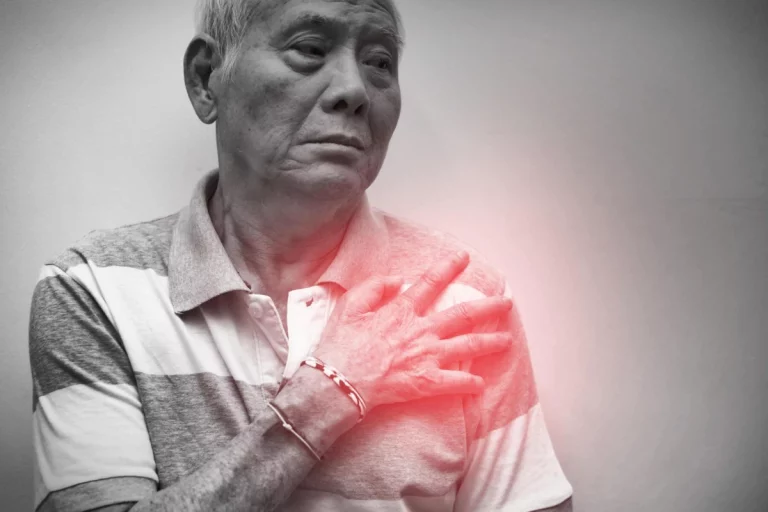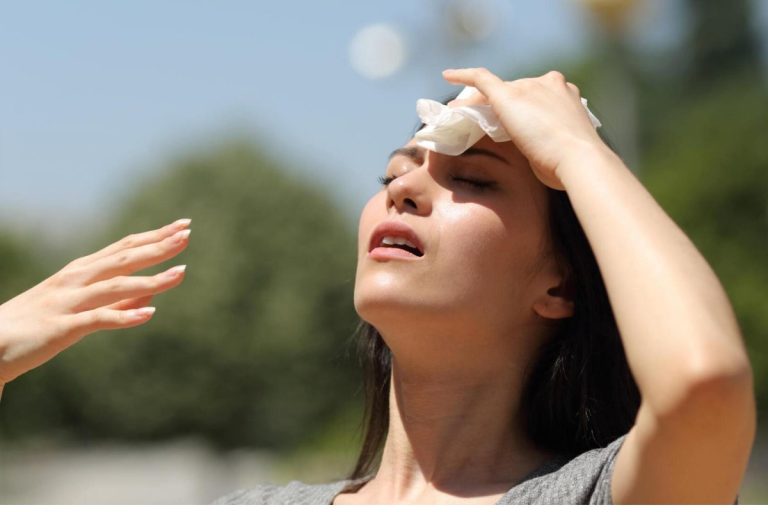Clammy skin is a condition where the skin becomes moist, calm, and sweaty to the touch.
This can occur in response to various stimuli, such as physical exertion, emotional stress, or as a symptom of an underlying medical condition.
While clammy skin can be uncomfortable, it is typically not life-threatening.
However, it indicates a more serious underlying issue and may require medical attention.
This outline will discuss the causes, symptoms, and treatment options for clammy skin.
Definition of clammy skin
Clammy skin refers to skin that is abnormally damp, moist, and cool to the touch, often accompanied by a sticky feeling.
It causes by the body’s natural response to stress, anxiety, or illness, which triggers the release of hormones that increase blood flow to the skin and cause sweat glands to produce more sweat.
Clammy skin might be a symptom of a medical emergency, such as shock or hypothermia.
It is necessary to seek medical attention if clammy skin accompanied by other symptoms such as chest pain, dizziness, or confusion.
Causes of Clammy Skin
Dehydration
It is a condition that occurs when the body loses more fluids than it takes in.
This happens due to different reasons, such as excessive sweating, vomiting, diarrhea, and not drinking enough water.
However, while the body loses fluids, it also loses essential electrolytes like sodium and potassium, which are necessary for the proper functioning of the body.
Dehydration causes various symptoms, including thirst, dry mouth, fatigue, dizziness, and in severe cases, confusion, rapid heartbeat, and even unconsciousness.
Treating dehydration promptly by drinking fluids and seeking medical attention in extreme cases is vital.
Low blood sugar
It, also known as hypoglycemia, is when the blood glucose (sugar) level falls below normal.
This can occur in people with diabetes who take certain medications or have trouble controlling their blood sugar, as well as in people who do not have diabetes.
Low blood sugar can cause many symptoms, including clammy skin, dizziness, confusion, shakiness, weakness, and fainting.
In severe cases, it can lead to seizures, coma, and even death if left untreated.
Shock
Shock is a medical emergency when the body’s organs and tissues do not receive enough blood flow and oxygen.
It can cause by various factors, including severe injury, blood loss, infections, allergic reactions, heart failure, or other medical conditions.
Symptoms of shock may include rapid heartbeat, rapid breathing, cool and clammy skin, confusion, lightheadedness, and sometimes loss of consciousness.
Shock treatment typically involves identifying and addressing the underlying cause and providing oxygen, fluids, and medications to support blood pressure and organ function.
Anxiety or panic attacks
Anxiety or panic attacks can also cause clammy skin. When a person experiences anxiety or panic, their body’s natural response triggers the fight or flight response, which can cause sweating and a drop in body temperature.
This drop in temperature can make the skin feel cool and clammy to the touch.
During a panic attack, a person’s heart rate and blood pressure can increase, causing increased sweating and moist skin.
Hypothermia
It is a medical emergency when a person’s body temperature drops below normal, typically below 95°F (35°C).
This condition can happen when the body exposed to cold temperatures for a prolonged period or when there is an excessive loss of body heat.
Hypothermia might be life-threatening and require instant medical attention.
Symptoms include shivering, confusion, drowsiness, shallow breathing, slow heart rate, severe loss of consciousness, or cardiac arrest.
It is essential to prevent hypothermia in cold environments, such as wearing warm clothing, staying dry, and seeking shelter when necessary.
Medications
Certain medications can also cause clammy skin as a side effect. For example, some blood pressure medications, such as beta-blockers, can cause the blood vessels in the skin to constrict, leading to reduced blood flow and clammy skin.
Other medications, such as opioids, can cause sweating and clammy skin as a side effect.
In some cases, damp skin may indicate an allergic reaction to the medication.
It’s essential to check with a healthcare provider if you experience clammy skin as a side effect of any medicine.
Other medical conditions
Clammy skin can be a symptom of various medical conditions such as heart attack, stroke, sepsis, hypothyroidism, and certain types of cancer.
In addition, some infectious diseases, such as malaria and dengue fever, can cause clammy skin.
It’s important to note that clammy skin is not a condition but a symptom that can indicate an underlying medical issue.
If you experience clammy skin and other signs or concerns, it’s essential to seek medical attention promptly to determine the underlying cause and receive appropriate treatment.
Symptoms of Clammy Skin
Skin feels cool and damp
When the skin feels cool and damp, it may indicate several underlying medical conditions.
One of the most common causes is dehydration, which occurs when the body loses more fluids than it takes in.
Another potential cause is low blood sugar, leading to cold sweats and clammy skin.
Shock is another condition that can cause cool and clammy skin, accompanied by other symptoms such as rapid heartbeat and shallow breathing.
Other potential causes of cool and damp skin include anxiety or panic attacks, hypothermia, certain medications, and other medical conditions.
Sometimes, it may be a side effect of medication, such as certain blood pressure or pain medications.
Medical conditions such as heart attack, stroke, and sepsis can also cause cool and clammy skin as a symptom.
It is imperative to look for medical attention if you are experiencing this symptom, especially if other concerning symptoms accompany it.
Skin appears pale or whitish
When the skin appears pale or whitish, it can be a sign of various medical conditions.
It can result from decreased blood flow, low blood pressure, anemia, shock, or hypothermia.
Certain medications or medical treatments can also cause pale or whitish skin. Sometimes, it may be a normal response to cold temperatures or fear.
If you notice persistent paleness or whitish color in your skin, especially if accompanied by other symptoms, it is essential to seek medical attention to determine the underlying cause.
Sweating
Sweating is the natural process of producing and excreting sweat through the sweat glands on the skin’s surface.
The primary function of sweating is to regulate body temperature by cooling the body through the evaporation of sweat from the skin’s surface.
Moreover, it contains mainly water and salt, and its production can be affected by various factors, such as physical activity, stress, and heat.
While sweating is normal, too much or at inappropriate times or places may indicate an underlying medical condition.
Diagnosis of Clammy Skin
Physical examination by a healthcare professional
A physical examination by a healthcare professional is a medical assessment of a person’s body.
It involves a trained healthcare provider examining a person’s body to assess their overall health, identify any signs of disease or injury, and provide appropriate medical care.
During a physical exam, a healthcare provider may check a person’s vital signs, including blood pressure, heart rate, and temperature.
They may also examine the person’s head, neck, chest, abdomen, arms, legs, and other body areas for abnormalities, tenderness, or swelling.
Depending on the individual’s health history, the healthcare provider may order additional tests or refer the person to a specialist for further evaluation.
A physical examination is essential to preventative care and can help identify health issues before they become more severe.
Review of medical history
A medical history review involves a detailed account of a patient’s past and present health conditions, surgeries, medications, and family medical history.
It helps healthcare professionals understand a patient’s health background and identify any underlying conditions contributing to their current symptoms or affecting their treatment plan.
Reviewing a patient’s medical history is essential to the diagnostic process and helps healthcare professionals make informed decisions about their patient’s care.
It also helps them determine the appropriate diagnostic tests, imaging studies, or lab work needed to arrive at an accurate diagnosis.
Diagnostic tests, such as blood tests, imaging studies, or skin tests
Healthcare professionals may conduct diagnostic tests to identify the underlying cause of clammy skin. Some examples of diagnostic tests include:
- Blood tests: These tests may used to check for abnormalities in blood sugar, electrolyte levels, thyroid function, or infection.
- Imaging studies: X-rays, CT scans, or MRI may be used to evaluate the internal organs and identify potential issues.
- Skin tests: A sweat test may determine if the skin produces enough sweat, which can indicate a condition like hypothyroidism or nerve damage.
The type of diagnostic test performed will depend on the suspected underlying cause of the clammy skin.
Treatment of Clammy Skin
Address underlying cause
Treating the underlying cause is essential in addressing clammy skin. Depending on the cause, treatment may include rehydration, controlling blood sugar levels, treating shock, managing anxiety or panic attacks, rewarming in cases of hypothermia, adjusting medication dosages or types, and managing other medical conditions.
In some cases, hospitalization might be necessary for further evaluation and treatment.
Consulting with a healthcare professional for proper diagnosis and treatment is important.
Drink an abundance of fluids
Drinking plenty of fluids, especially water, can help to treat and prevent dehydration which can cause clammy skin.
Staying hydrated by drinking fluids regularly, especially during hot weather, or engaging in physical activity, is essential.
Maintain proper blood sugar levels
The low blood sugar (hypoglycemia) that can lead to clammy skin, it is essential to follow a healthy diet that includes regular meals and snacks and to take any prescribed medications for diabetes as directed by a healthcare provider.
Frequently checking blood sugar levels helps to manage and prevent low blood sugar episodes.
Use warm blankets or a heating pad for hypothermia
Warm blankets or a heating pad can help raise body temperature in cases of hypothermia.
However, avoiding direct heat sources, such as hot water or a heating lamp, is vital as these can cause burns.
It is also essential to seek medical attention if you suspect hypothermia, as severe cases can be life-threatening and require urgent medical treatment.
Medications, such as anti-anxiety drugs or medications to control blood sugar levels
Medications prescribed to address the underlying cause of clammy skin.
For example, anti-anxiety drugs prescribed to help manage anxiety or panic attacks, while medications to control blood sugar levels given for low blood sugar.
However, medications will depend on the underlying cause of clammy skin and should only prescribe by a healthcare professional.
Other treatments as necessary
The specific treatment for clammy skin depends on the underlying cause.
In addition to addressing the primary cause, other treatments may be necessary to manage the symptoms and complications of clammy skin.
For example, someone experiencing dehydration may need intravenous fluids to replenish lost fluids and electrolytes. In cases of hypothermia, rewarming the body with blankets or other methods may be necessary.
In cases of shock, medications and intravenous fluids may be needed to improve blood flow and oxygenation to the body’s organs.
It is vital to get medical attention if other concerning symptoms accompany clammy skin or do not improve with simple interventions.
Prevention of Clammy Skin
Drink plenty of fluids
Drinking plenty of fluids is a standard treatment for clammy skin, primarily if it caused by dehydration.
Drinking water, sports drinks, or additional fluids that can replace lost electrolytes recommended.
In rigorous cases of dehydration, intravenous fluids may be necessary.
However, it is necessary to consult a healthcare professional to determine the underlying cause of clammy skin and the appropriate amount and type of fluids to consume.
Dress appropriately for the weather
Dressing appropriately for the weather is vital to prevent clammy skin or hypothermia. However, wearing warm clothes help to maintain body heat and to avoid hypothermia in cold weather.
Wearing loose, breathable clothing in hot weather can help prevent overheating and dehydration. It’s also important to protect the skin from the sun’s harmful UV rays by wearing an appropriate dress, sunscreen and seeking shade.
Monitoring Blood Sugar Levels for People with Diabetes
Monitoring blood sugar levels is vital for people with diabetes to avoid hypoglycemia (low blood sugar), which can cause clammy skin, among other symptoms.
Maintaining normal blood sugar levels through proper diet, exercise, and medication management can help prevent episodes of hypoglycemia.
Avoid triggers for anxiety or panic attacks
Some strategies may avoid triggers for anxiety or panic attacks include:
- Identifying triggers: Learn to recognize situations or circumstances that trigger anxiety or panic attacks. Common triggers include stress, fear, caffeine, alcohol, smoking, and certain foods.
- Practicing relaxation techniques: Meditation, deep breathing exercises, and yoga can help to reduce stress and anxiety.
- Regular exercise: Regular physical activity can help reduce anxiety and improve overall health.
- Avoiding stimulants: Reduce or avoid caffeine, nicotine, and other stimulants that can trigger anxiety.
- Getting enough sleep: Sleep is vital for overall health and can help to reduce anxiety.
- Seeking support: Talk to a therapist or mental health professional to help manage anxiety or panic attacks. Support groups can also provide helpful tips and encouragement.
Talk to your healthcare provider about adjusting medications if necessary
This advice typically given to individuals. Depending on the medication, changing the dose or switching to alternative medicine may be required to alleviate symptoms of clammy skin.
It’s necessary to converse with a healthcare provider before making any changes to medication.
Conclusion
Summary of key points
- Clammy skin is a condition that feels cool and damp to the touch and may appear pale or whitish.
- It can cause by a variety of factors, including dehydration, low blood sugar, shock, anxiety or panic attacks, hypothermia, medications, and other medical conditions.
- A healthcare professional performs a physical examination and reviews medical history to help determine the underlying cause of clammy skin.
- Diagnostic tests, such as blood tests, imaging studies, or skin tests, may also be performed.
- Treatment for clammy skin depends on the underlying cause. It may include addressing dehydration, maintaining proper blood sugar levels, using warm blankets or a heating pad for hypothermia, medications, or other treatments as necessary.
Generally, it is crucial to drink plenty of fluids, dress appropriately for the weather, monitor blood sugar levels if you have diabetes, avoid anxiety or panic attack triggers, and talk to your healthcare provider about adjusting medications if necessary.
The Significance of Seeking Medical Care if Symptoms of Clammy Skin Persist or Deteriorate
It is essential to seek medical attention if clammy skin persists or worsens, as it can indicate an underlying medical condition.
A healthcare professional can conduct a physical examination and review medical history to determine the underlying cause; diagnostic tests may also be necessary.
Treatment may include addressing the underlying cause, maintaining proper blood sugar levels, staying hydrated, dressing appropriately for the weather, and taking medications as necessary.
Following the healthcare provider’s instructions and seeking follow-up care as needed is essential.
People also ask
1. What does it mean when your skin is clammy?
Clammy skin feels damp, cool, and slightly sticky to the touch. It can cause by sweating, nervousness, illness, or an underlying medical condition like hypoglycemia, heart attack, shock, or heat exhaustion. If accompanied by other symptoms, seeking immediate medical attention is essential.
2. Is it normal to be clammy?
It’s normal to have clammy skin when sweating due to physical activity, hot weather, or emotional stress.
If you are experiencing clammy skin without an apparent cause or with other symptoms, it could indicate an underlying medical condition.
It is advisable to seek medical evaluation and advice from a healthcare professional.
So, it is not always typical to be clammy, and it’s essential to pay attention to other symptoms and seek medical attention if needed.
3. What illness makes you feel clammy?
Several illnesses can cause clammy skin, including hypoglycemia, heart attack, shock, heat exhaustion, and certain infections like sepsis and malaria. If you experience moist skin with other concerning symptoms, it’s essential to seek medical attention promptly.
4. What causes cold, clammy sweats?
A cold and damp feeling of sweating characterizes cold, clammy sweats.
This can occur for various reasons, such as anxiety or panic attacks, low blood sugar in individuals with diabetes, heart attacks, shock, and certain infections like sepsis, malaria, or influenza.
These conditions trigger the body’s response, causing cold, clammy sweats, and other symptoms such as rapid heartbeat, chest pain, shortness of breath, fever, and nausea.
Cold, clammy sweats may indicate a medical emergency, and it is vital to seek medical attention if you experience them along with other concerning symptoms.
Related Searches
- cold clammy skin meaning
- Image of Clammy skin images
- clammy skin no fever
- clammy skin shortness of breath
- clammy skin at night
- clammy skin medical term
- clammy skin nausea fatigue
- Clammy skin images
- clammy skin no fever
- skin care in hindi wellhealthorganic








